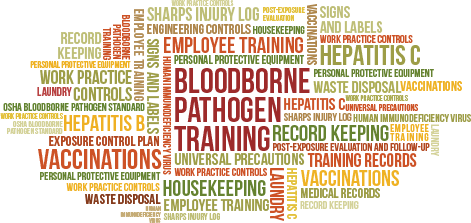This course meets the educational requirements for federal OSHA Bloodborne Pathogens Standard training.
Workplace-specific policies, procedures, or training are the responsibility of your employer, who must also provide an opportunity for “interactive questions and answers” with a “person who is knowledgeable” about this subject.
Authors:
Tracey Long, PhD, RN, APRN
JoAnn O’Toole, RN, BSN
Contact hours: 2
AOTA CEUs: 0.2
Expiration date: August 1, 2026
Course price: $19*
*Register or login when you reach the last chapter.
Course Summary
Review of precautions that address the transmission of pathogens in healthcare settings. Includes safe handling of sharps, use of PPE, and decontamination of work areas, plus importance of hepatitis B vaccination for workers.
Target Audience
Nurses, nurse practitioners, advanced practice nurses, physical therapists, physical therapy assistants, occupational therapists and occupational therapy assistants*.
*If you are an OT or OTA, you may need the following information for relicensure:
![]() ATrain Education is an AOTA Approved Provider of professional development. Approved provider #6558. This distance learning-independent is offered at 0.2 CEUs, introductory, Foundational Knowledge. The assignment of AOTA CEUs does not imply endorsement of specific course content, products, or clinical procedures by AOTA.
ATrain Education is an AOTA Approved Provider of professional development. Approved provider #6558. This distance learning-independent is offered at 0.2 CEUs, introductory, Foundational Knowledge. The assignment of AOTA CEUs does not imply endorsement of specific course content, products, or clinical procedures by AOTA.
Conflict of Interest / Commercial Support
The planners and authors of this learning activity have declared no conflicts of interest, vested interest, or financial relationship that may influence the content of this activity. All information is provided fairly and without bias.
ATrain Education, Inc. received no outside financial or commercial support in the preparation, presentation or implementation of this learning activity and has no affiliation with any company whose products or services are mentioned in this activity.
Criteria for Successful Completion
Study the course material, achieve a score of 80% or higher on the post test (the post test can be repeated if a learner scores less than 80%), complete the course evaluation, and pay where required. No partial credit will be awarded.
Accreditation
To find specific accreditations or approvals, click here.
Course Objectives
When you finish this course you will be able to:
- Explain the hazards of bloodborne pathogens (HBV, HCV, HIV) in the transmission of certain chronic and life-threatening diseases and relate both OSHA and state laws designed to control them.
- Outline the actions employers are required by OSHA to take to protect their employees from bloodborne pathogens in the workplace.
- Explain safe handling and disposal of sharps.
- Compare and contrast Universal and Standard Precautions and describe other work place practices to control pathogen contamination.
- Review the selection and use of personal protective equipment.
- Summarize the required training of healthcare personnel and identify the common symbol and color of hazardous signs.
- Outline the OSHA requirements for housekeeping, regulated waste, soiled laundry, and vaccination against hepatitis B.
- Discuss the procedure for promptly reporting an exposure incident.
*Please note: attainment of course objectives will be assessed in the course evaluation.

